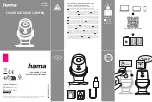
69
SPECIFICATIONS & PERFORMANCE
Degree of protection against harmful ingress of water: IPX0
The TRC-NW8 has no protection against ingress of water. (The degree of protection against
harmful ingress of water defined in IEC 60529 is IPX0.)
Classification according to the method(s) of sterilization or disinfection recom-
mended by the manufacturer: not applicable.
The TRC-NW8 has no part to be sterilized or to be disinfected.
Classification according to the degree of safety of application in the presence of a
flammable anesthetic mixture with air or with oxygen or nitrous oxide: Equipment
not suitable for use in the presence of a flammable anesthetic mixture with air or
with oxygen or nitrous oxide.
The TRC-NW8 should be used in environments where no flammable anesthetics and/or flam-
mable gases are present.
Classification according to the mode of operation: Continuous operation.
Continuous operation is the operation under normal load for an unlimited period, without the
specified limits of temperature being exceeded.
DIMENSIONS AND WEIGHT
Dimensions : 274mm (W) × 508mm (D) × 536 - 566mm (H)
Weight
: 23.5kg
PURPOSE OF USE
To observe and photograph the fundus through the pupil and document it.
OPERATION PRINCIPLE
The fundus of the patient's eye is illuminated by the infrared light emitted from the illumination
optical system. The observation CCD camera built into the instrument receives the image and
the image is indicated on the color LCD monitor allowing the operator to observe the fundus.
After adjusting the photography position and focus, the visible light is emitted from the illumina-
tion optical system provided for photography by operating the photography switch of the instru-
ment. The digital camera, which is connected to the instrument, receives the image and then
the image is recorded in the memory card built into the digital camera or the connected image
filing system or external recording device, which is a commercial product.
The fundus of the patient's eye can also be illuminated, observed and photographed by the vis-
ible light after removing the IR filter from the illumination optical system. Moreover, it is possi-
ble to perform red-free observation and photography by inserting the RF filter into the
illumination optical system.
















































